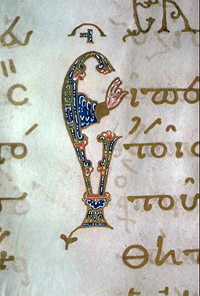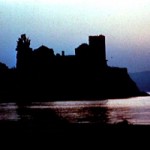Predrag Matejic recently returned from a trip to Bulgaria and Serbia with a number of books donated to the Hilandar Research Library by various individuals and institutions. The Serbian Academy of Science and Art presented Dr. Matejic with copies of volumes 12 and 13 of Hilandarski zbornik.
An invaluable work found in volume 13 is Mirko Kovačević’s article on the Hilandar monastic residence, the “white konak,” which was mostly written before the fire of 2004. The article includes detailed architectural drawings and photographs of the building’s interior, exterior, and various ornamental features, as well as devastating images of the ruined structure after the fire.
 Table of contents for volume 12 (2008):
Table of contents for volume 12 (2008):
Калић, Јованка. “Растко Немањић, истраживања”/Kalić, Jovanka. “Rastko Nemanjić – Research.”
Благојевић, Милош. “Хиландарски поседи на Косову и Метохији (XII-XV век)”/Blagojević, Miloš. “Chilandar estates in Kosovo and Metohija (12th-15th centuries).”
Bogdanović, Jelena. “Some Additional Observations on the Original Tomb of St. Simeon at Hilandar and its Significance for the Architectural History of the Monastery”/Богдановић, Јелена. “Првобитни гроб св. Симеона и његов значај за историју архитектуре манастира Хиландар.”
Pavlikianov, Kyrill. “Unknown Slavic Charter of the Serbian Despot John Ugleša in the Archive of the Athonite Monastery of Vatopedi”/Павликијанов, Кирил. “Непознат словенски акт српског деспота Јована Угљеше из Архива атонског манастира Ватопеда.”
Бубало, Ђорђе. “Прилози српској дипломатици”/Bubalo, Djordje. “Four Studies on Serbian Diplomatics.”
Јовановић, Томислав. “Карејски и Хиландарски типик у руском преводу из збирке Белокриницког манастира”/Jovanović, Tomislav. “Karayas’ and Chilandar typicons in the Russian translation from the Belokrinici monastery.”
Ракић, Зоран. “Црква Светог Саве Српског у Хиландару”/Rakić, Zoran. “The Church of St. Sava in Chilandar.”
Бобров, Юрий, Боян Милькович. “Карейская Богородица Млекопитательница. Краткая история и превоначальный вид”/Бобров, Јуриј, Бојан Миљковић. “Карејска Богородица Млекопитатељница. Кратка историја и првобитни изглед.”
Иванић, Бранка. “Прилог тумачењу сликаног програма параклиса Светог Ђорђа на пиргу Светог Ђорђа у Хиландару”/Ivanić, Branka. “Additional Interpretation of the Iconographic Programme on the Parecclesion of St. George’s Tower at Chilandar.”
Fotić, Aleksandar. “Xenophontos in the Ottoman Documents of Chilandar (16th-17th century)”/Фотић, Александар. “Ксенофонт у османским документима манастира Хиландар (16-17. век).”
Стошић, Љиљана. “Једна непозната илустрована Библија из ризнице манастира Хиландара”/Stošić, Ljiljana. “An Unknown Illustrated Bible from the Chilandar Treasury.”
Peno, Vesna. “Hilandar Church Chanting in 19th Century in the Frame of Mount Athos Music Tradition.”/Пено, Весна. “Светогорска музичка традиција и црквено појање у Хиландару у XIX веку.”

Table of contents for volume 13 (2011):
Томовић, Гордана.“Манастир Светог Ђорђа и село Уложишта на Дреници”/Tomović, Gordana. “The Saint George Monastery and the Village Uložišta on the Mount Drenica.”
Ковачевић, Мирко.“Конак обновљен 1598/1615. године – Бели конак (25)”/Kovačević, Mirko. “The Restoration of the Konak 1598/1615 – the White Konak (25).”
Петковић, Сретен. “Фреске XVII века у цркви Светог Геогрија у Хиландару”/Petković, Sreten. “17th Century Frescoes from the Church of St. George at Chilandar.”
Пено, Весна. “Мелод и писар Герман Неон Патрон у хиландарским музичким рукописима”/Peno, Vesna. “Melod and Scribe Germanos Neon Patron in Chilandar Music Manuscripts.”
Трипковић, Стевица М. “Обнова конака из 1814. године у манатиру Хиландару”/tripković, Stevica M. “The 1814 Restoration of the Monastic Quarters at Chilandar.”
Бубало, Ђорђе. “Хиландар и стонски доходак у XIX веку”/Bubalo, Djordje. “Chilandar and the Ston Tribute in the 19th Century.”















